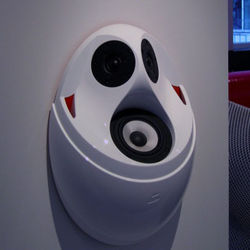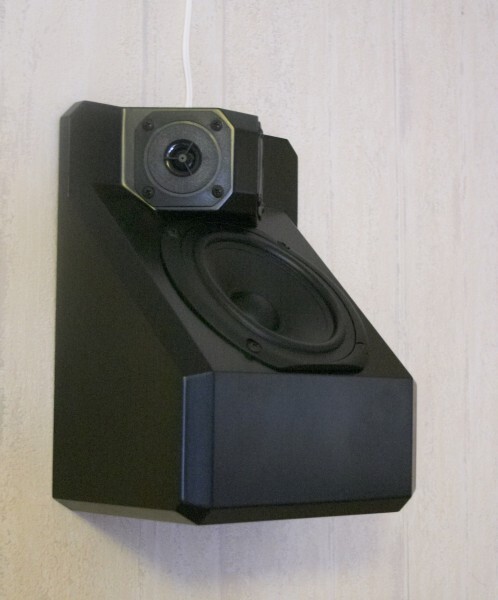I intend to build some shallow on wall speakers as I need to listen relative close to the wall (7-8ft) and want to avoid all the problems with speakers positioned close to walls. Many designs I found (commercial or diy) are just shallow boxes with walls perpendicular to the front baffle. In contrast to in wall speakers there is a distance between wall and front baffle which will cause diffractions, back reflections, comb filtering and psychoacoustic merging of direct and back reflected sound. This effect will be dependent on depth of the shallow box in a frequency dependent manner. If it is only 3-4" deep I assume that it will matter only above 600 -1000Hz (1/4 wavelength).
I can think of 2 options to avoid these mid and high frequency effects:
edgeless design i.e. 1/4 circle shaped sides. This would avoid edge reflections but much more involved to make.
covering the sidewalls with (wool) felt, potentially slightly extending past the front baffle. Felt is an effective absorber at higher frequencies but will it be sufficient?
I can think of 2 options to avoid these mid and high frequency effects:
edgeless design i.e. 1/4 circle shaped sides. This would avoid edge reflections but much more involved to make.
covering the sidewalls with (wool) felt, potentially slightly extending past the front baffle. Felt is an effective absorber at higher frequencies but will it be sufficient?
On wall speaker
Monteverdi:
I like the idea of the 1/4 curve, but it would be more involved. If you built ribs such as in a airplane wing, you could use bendy plywood to cover it. Not too terrible.....
You could also use a very heavy cardboard tube, and cut it. I came across some 5/8" thick, 14" diameter, 18" long tubes that were cores from super heavy rolls of paper at a newapaper publisher. They were free.
Good luck!
Monteverdi:
I like the idea of the 1/4 curve, but it would be more involved. If you built ribs such as in a airplane wing, you could use bendy plywood to cover it. Not too terrible.....
You could also use a very heavy cardboard tube, and cut it. I came across some 5/8" thick, 14" diameter, 18" long tubes that were cores from super heavy rolls of paper at a newapaper publisher. They were free.
Good luck!
Consider the size of the baffle. This is the first line of defense (against the wall). Not only do you want it to establish wavefronts for all frequencies down to (your choice). You also want to consider the distance from the baffle back to the wall, which frequencies will find it an issue, and how the baffle finds them when they reach the edge. Then yes, roundover.
edgeless design i.e. 1/4 circle shaped sides. This would avoid edge reflections but much more involved to make.
It will avoid a reflection off the rounded away front edge but there will still be a 90 degree internal corner at the wall. Would a 45 degree chamfer be better or worse?
covering the sidewalls with (wool) felt, potentially slightly extending past the front baffle. Felt is an effective absorber at higher frequencies but will it be sufficient?
The rule of thumb for absorbers of appropriate material to work well is a depth of a quarter of a wavelength or better. So yes a 4" deep and 4" wide halo could be effective. But the width and height of the speaker will be getting pretty large. Will absorbing material work better or worse than a hard round over or chamfer?
A few additional points. The length from the driver across the baffle and down the side to the front wall and back again along the side is the relevant distance for half wave length cancellation. This is a significantly lower frequency than that for a quarter wavelength based on speaker depth.
If you leave a sharp front edge then the above main cancellation dip and that from the quarter wavelength speaker depth will interfere. This may be helpful.
If you position the driver off-centre, vary the speaker depth,... this will also smear the cancellation dips.
A reasonably large driver will start to beam forward at midrange frequencies which could lead to low levels of sound at relevant frequencies associated with cancellation dips off the front wall.
You don't say if your speaker is a two or three way. If it is a three way then arranging for the cancellation off the front wall for the woofer to be at a frequency above the mid/woofer crossover frequency (i.e. position close to wall) and for the midrange to be below the crossover frequency (i.e. position a long way from the wall) would be an effective way to tackle the problem without having to resort to a large front baffle.
You have set yourself an interesting project. Will be good to know what you plump for and how it works out.
I am planning to use my design of bending wave driver which are linear from 200Hz up and have like other bending wave drivers very wide dispersion. Thus it will be a 2 way design but finding a suitable woofer will be challenging. One alternative is to use a pair of subwoofers which are designed for wall placement and wide frequency range like BW-2 | Lyngdorf Audio. The issue of this idea is the distance between sub and main speaker.
Presently I am using my bending wave driver in a large circular front baffle mounted very eccentric to have a continuous varying distance from driver to baffle edge. I could use this idea for the on wall but a rectangular baffle would fit much more the room design.
I was contemplating 45º sides (could be even made with felt) but one design option I am thinking of is that the baffle is itself wedge (triangular) shape. That will require a larger baffle size and to avoid diffraction the corner between the 2 sides needs to be rounded. Still top and bottom sides needs to be dealt with.
Presently I am using my bending wave driver in a large circular front baffle mounted very eccentric to have a continuous varying distance from driver to baffle edge. I could use this idea for the on wall but a rectangular baffle would fit much more the room design.
I was contemplating 45º sides (could be even made with felt) but one design option I am thinking of is that the baffle is itself wedge (triangular) shape. That will require a larger baffle size and to avoid diffraction the corner between the 2 sides needs to be rounded. Still top and bottom sides needs to be dealt with.
See the link below for the Wavecor WaveWall-182 with 45 degree sloped sides.
DIY Speaker | WaveWall-182 | On-wall |
DIY Speaker | WaveWall-182 | On-wall |
Last edited:
A woofer/wideband is effectively the same as a woofer/midrange in a 3 way. So place your woofer/s on the side of the speaker and your wideband driver on the front of a conventional deep speaker not a shallow one. A force cancelling pair of woofers is attractive given they are going on the side. For a crossover in the 200-250 Hz region the woofer cancellation dip should be comfortably above this frequency and the one for the wideband driver comfortably below. The steeper the crossover slope the better. Roundover of the baffle edge is now optional.I am planning to use my design of bending wave driver which are linear from 200Hz up and have like other bending wave drivers very wide dispersion. Thus it will be a 2 way design but finding a suitable woofer will be challenging.
- Home
- Loudspeakers
- Multi-Way
- sidewall design of on wall speakers

